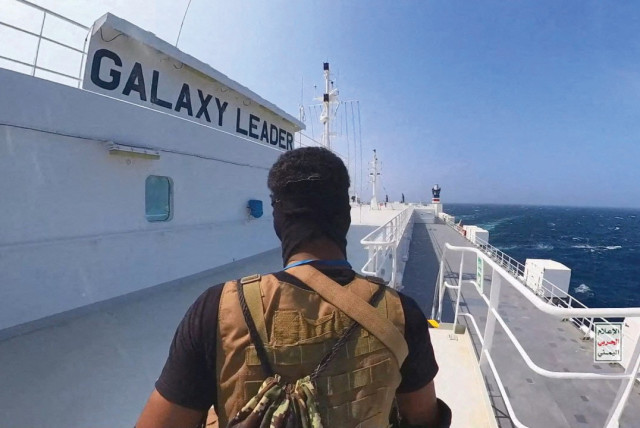Iran causes crisis with drone threat, from Red Sea to Indian Ocean

Iran backs the Houthis in attacks on ships and expands the area it threatens.
Iran denied on Saturday US accusations that it was involved in planning attacks by Yemen’s Tehran-aligned Houthi movement on commercial vessels in the Red Sea, the semi-official Mehr news agency reported. The repeated denial, issued by Iranian deputy foreign minister Ali Bagheri Kani, came after the White House said Tehran was “deeply involved” in planning the operations and its intelligence was critical to enable the Houthis to target ships.
“The resistance [Houthis] has its tools of power and acts according to its decisions and capabilities,” Bagheri Kani told Mehr.
Iran supports the Houthis, but officially denies arming the group, which has seized Yemen’s capital Sana’a after ousting the government and now controls large swaths of the country.
The Houthis, who say their attacks are aimed at Israel-linked ships and are in support of Palestinians under siege by Israel in Gaza, have targeted commercial shipping in the Red Sea with drones and missiles, forcing shippers to change course and take longer routes around the southern tip of Africa.
The Houthis claim they are backing Hamas in Gaza. Since Iran backs both terrorist groups, it now appears to have joined the Houthi attacks on ships by carrying out a long-range drone attack on a chemical tanker in the Indian Ocean. By doing so, Iran has created an arc of drone threats that stretches from Yemen to Chabahar in Iran near the border with Pakistan.
According to the BBC, “A chemical tanker in the Indian Ocean was hit by a drone launched from Iran on Saturday, the US military says. A fire on board the Chem Pluto was extinguished. There were no casualties.”
The attack on the ship in the Indian Ocean took place on Saturday. The day before, the US had accused Iran of being involved with Houthi threats to shipping in the Red Sea. “The White House publicly released US intelligence as the Iranian-linked Yemeni insurgents persist with ship strikes they say are in solidarity with Palestinians in the Gaza Strip, where Israel is battling Hamas [terrorists],” CBS reported.
“The White House said that Tehran’s clerical state has provided drones and missiles to the Houthis as well as tactical intelligence,” it said. National Security Council spokeswoman Adrienne Watson said, “We know that Iran was deeply involved in planning the operations against commercial vessels in the Red Sea.”
US Central Command said that “between 3 and 8 p.m. (Sana’a time), the USS Laboon (DDG 58) was patrolling in the southern Red Sea as part of Operation Prosperity Guardian (OPG) and shot down four unmanned aerial drones originating from Houthi-controlled areas in Yemen that were inbound to the USS Laboon. There were no injuries or damage in this incident.”
Sign of Iran's growing confidence
Prosperity Guardian is a group of predominantly Western countries that have agreed to help provide security in the Red Sea after numerous attacks.
Iran has developed long-range kamikaze drones over the last decade, beginning basing some in Yemen as early as late 2020. A 2021 report in Newsweek claimed Shahed-136 drones had been seen in Yemen on satellite photos, drones that Iran later exported to Russia the following year.
Tehran also used a kamikaze drone to attack a ship off the coast of Oman in November 2022, reportedly flown from Chabahar in Iran. At the time, US Central Command said that an examination of the “debris that hit the vessel reveals that it was a Shahed-series one-way attack drone.”
The shipping lanes now threatened in the Red Sea – off the coasts of Oman, Yemen Iran, and now India – are vast. However, Iran has been able to make this large area of open water smaller by basing drones at home and in Yemen.
The November 2022 attack on the Pacific Zircon occurred around 240 km. off the coast of Oman, while another attack on the Mercer Street ship in July 2021 killed two people, also off the coast of Oman. Iran appears to have shown that it can expand the range of its drones to strike ships further out to sea.
The attacks pose a growing risk to international shipping. Those in the Red Sea, for instance, caused Washington to deploy more naval assets to the area. If Iran expands its attacks to the Indian Ocean, it will create a second crisis. What is happening now appears to be its opening salvo, building on the incidents in 2021 and 2022.
Iran has not faced retaliation in the past, and it likely won’t face it now. Tehran also mined ships off the coast of the UAE and attacked others in June 2019.
Each time, the Islamic Republic seeks to cause a crisis at a time and place of its choosing, forcing the US and other partners to spread their resources thin in a vast area of ocean. This is now the case regarding the Red Sea and the new attacks in the Indian Ocean.
Reuters contributed to this report.
Jerusalem Post Store
`; document.getElementById("linkPremium").innerHTML = cont; var divWithLink = document.getElementById("premium-link"); if (divWithLink !== null && divWithLink !== 'undefined') { divWithLink.style.border = "solid 1px #cb0f3e"; divWithLink.style.textAlign = "center"; divWithLink.style.marginBottom = "15px"; divWithLink.style.marginTop = "15px"; divWithLink.style.width = "100%"; divWithLink.style.backgroundColor = "#122952"; divWithLink.style.color = "#ffffff"; divWithLink.style.lineHeight = "1.5"; } } (function (v, i) { });

